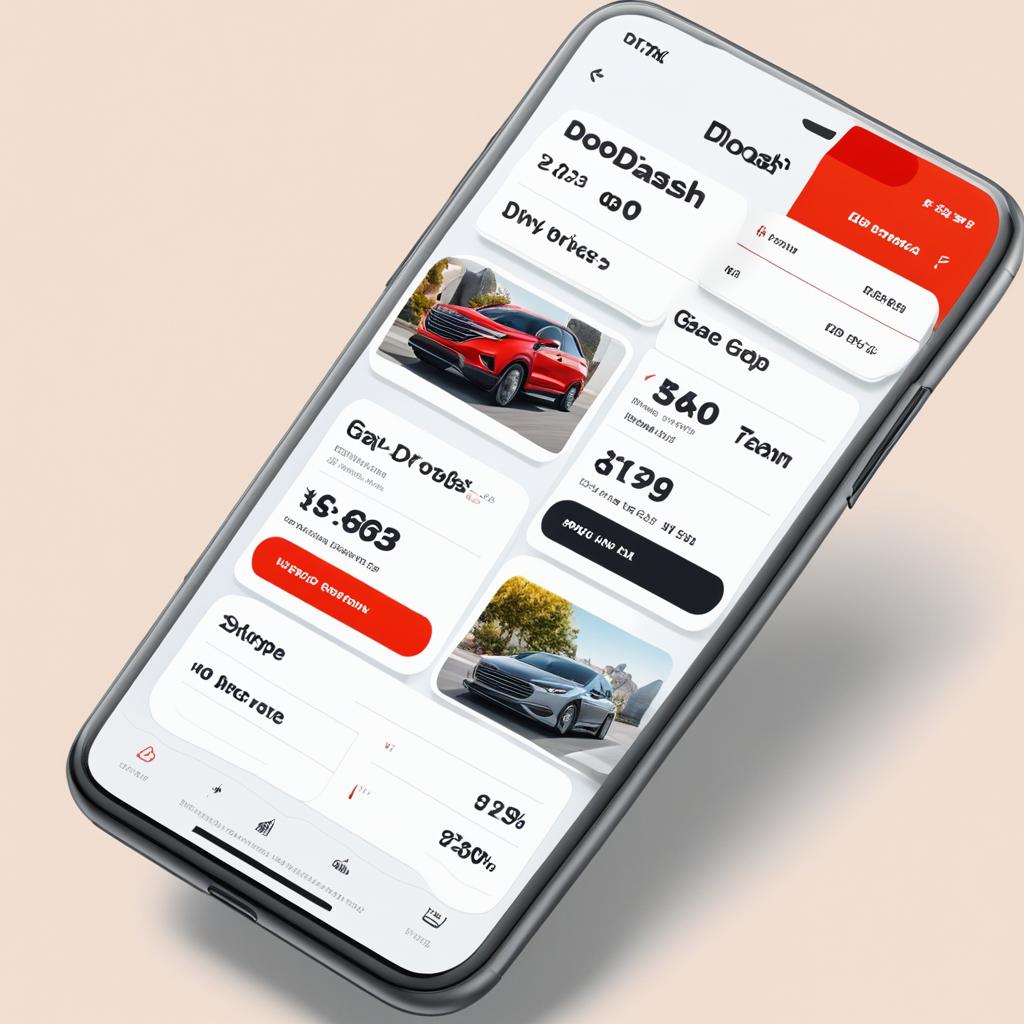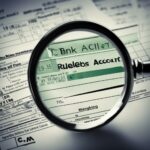If you’re a DoorDash driver and earned $600 or more in a given year, it’s important to understand how to navigate your tax obligations. Filing taxes as a DoorDash driver may seem overwhelming, but with the right guidance, it can be a straightforward process. In this comprehensive tax guide, I will provide you with all the information you need to know about DoorDash taxes, including how to file your taxes, tax-saving tips, deductible expenses, and more.
As a DoorDash driver, it’s crucial to be aware of your tax responsibilities. DoorDash does not withhold taxes from your earnings, which means you are responsible for calculating and paying your taxes. This guide will help you understand the ins and outs of DoorDash taxes, ensuring you stay compliant with IRS regulations and minimize your tax liability.
Key Takeaways:
- DoorDash drivers who earn $600 or more in a year are responsible for filing and paying taxes.
- DoorDash does not withhold taxes from driver earnings, so drivers must calculate and pay their tax liability.
- The DoorDash 1099-NEC form reports your earnings and is used to file taxes.
- DoorDash drivers can deduct business expenses such as mileage, vehicle expenses, and delivery equipment.
- Quarterly estimated tax payments may be required for self-employed individuals.
Understanding DoorDash Taxes
As a DoorDash driver, I understand the importance of knowing my tax obligations. DoorDash does not withhold taxes from my earnings, which means I am responsible for calculating and paying my tax liability. To help you navigate through the complexities of DoorDash taxes, this section will provide an overview of what you need to know to stay compliant.
When it comes to understanding DoorDash taxes, there are a few key points to keep in mind:
- Calculating Your Taxes: As an independent contractor, I am considered self-employed, which means I am responsible for paying self-employment taxes. This includes Social Security and Medicare taxes. It’s important to calculate your tax liability accurately to avoid any penalties or audits.
- Filing Requirements: If you earn $600 or more as a DoorDash driver in a given year, you will receive a Form 1099-NEC from DoorDash. This form reports your total earnings and is used to file your taxes.
- Tax Deductions: As a DoorDash driver, there are various tax deductions you may be eligible for. These deductions can help lower your tax liability and increase your take-home pay. Some common deductions include mileage, vehicle expenses, phone and internet expenses, and delivery equipment expenses.
Navigating DoorDash taxes may seem overwhelming at first, but with proper understanding and planning, it can be manageable. By keeping detailed records, tracking your expenses, and consulting with a tax professional if needed, you can ensure that you are meeting your tax obligations while maximizing your deductions.
“Understanding your tax obligations as a DoorDash driver is essential to staying compliant and avoiding any unnecessary penalties. Take the time to educate yourself on the requirements and consult with a tax professional if needed.”
Beyond Taxes: Financial Planning for DoorDash Drivers
While understanding and managing your DoorDash taxes is important, it’s also crucial to have a comprehensive financial plan to secure your financial future. As a DoorDash driver, you have the flexibility of being your own boss, but it also means you’re responsible for your own financial well-being.
Here are a few financial planning tips specifically tailored for DoorDash drivers:
- Create a Budget: Keep track of your income and expenses to ensure you are setting aside enough money for taxes, savings, and everyday expenses.
- Save for Retirement: As a self-employed individual, you don’t have access to employer-sponsored retirement plans. Consider opening an Individual Retirement Account (IRA) or a Simplified Employee Pension (SEP) IRA to save for retirement.
- Build an Emergency Fund: DoorDash driving can be unpredictable, so having an emergency fund can provide a financial safety net during unexpected situations or slow periods.
Remember, financial planning goes beyond just taxes. It’s about setting yourself up for long-term financial success and stability. Take the time to evaluate your financial goals and seek guidance from a financial planner if needed.
Now that you have a better understanding of DoorDash taxes and the importance of financial planning, you can confidently navigate the world of self-employment and maximize your earnings. Stay organized, stay informed, and remember to consult with a tax professional for personalized advice.
The DoorDash 1099-NEC Form
If you earn $600 or more as a DoorDash driver, you will receive a Form 1099-NEC from DoorDash. This form reports your total earnings for the year and is used to file your taxes. It is important to keep track of your earnings and expenses throughout the year to accurately report your income on your tax return.
As an independent contractor, DoorDash does not withhold taxes from your earnings. Instead, you are responsible for calculating and paying your tax liability. The Form 1099-NEC helps both you and the IRS keep track of your income and ensures you fulfill your tax obligations.
The Form 1099-NEC will provide you with the necessary information to accurately report your earnings on your tax return. It will include your total DoorDash earnings for the year, which you will need to report as self-employment income.
Make sure to carefully review your Form 1099-NEC to ensure the information is correct. If you notice any discrepancies or errors, reach out to DoorDash for assistance.
Keeping Track of your Earnings and Expenses
To accurately report your income and claim any eligible deductions, it is crucial to keep track of your DoorDash earnings and expenses throughout the year.
Use a spreadsheet, accounting software, or a dedicated expense tracking app to record all your deliveries and related expenses. This will help you have an organized and comprehensive record of your business activities.
Keep track of the following:
- The dates and times of each delivery
- The delivery locations
- The amount earned for each delivery
- Relevant expenses such as gas, car maintenance, and tolls
Staying organized will not only make it easier to file your taxes but also ensure you don’t miss out on any deductions or overstate your income. Remember, accurate record-keeping is essential to ensure compliance with IRS regulations.
With accurate records and the Form 1099-NEC in hand, you’ll be well-prepared to tackle your DoorDash taxes with confidence.
Calculating Your DoorDash Tax Liability
As an independent contractor, it’s important to understand your tax liability and obligations as a DoorDash driver. One crucial aspect is calculating your taxes accurately to avoid any surprises when tax season arrives.
To calculate your DoorDash tax liability, you’ll need to determine your net income from your deliveries. This includes the total amount you earned minus any eligible deductions and expenses.
Once you have your net income, you’ll then apply the appropriate tax rates and deductions to determine your tax liability. As a self-employed individual, you’re responsible for paying the self-employment tax, which includes Social Security and Medicare taxes.
Estimating your tax payments
To ensure you’re prepared for your tax obligations, it’s wise to estimate your tax payments throughout the year. By setting aside a portion of your earnings, you can avoid any financial strain when it comes time to pay your taxes.
A helpful way to estimate your tax payments is to calculate your expected taxable income for the year based on your current earnings. You can use this estimate to determine how much you should set aside each month or quarter to cover your tax liability.
Self-Employment Tax Rates
Self-employment tax rates consist of both the Social Security tax and the Medicare tax. The current rates for self-employment taxes in the United States are as follows:
| Tax Rate | Applicable Income |
|---|---|
| 12.4% | Up to $142,800 |
| 2.9% | Any income above $142,800 |
Note: These rates are based on the current tax year and are subject to change. It’s always advisable to refer to the IRS guidelines or consult with a tax professional to ensure you have the most accurate and up-to-date information.
Remember, calculating your DoorDash tax liability is an important part of being a responsible and compliant independent contractor. By estimating your tax payments and setting aside the necessary funds, you can ensure a smooth tax filing process and avoid any penalties or fines.
Next, in Section 5, we’ll explore the various tax deductions available to DoorDash drivers, which can help reduce your overall tax liability and maximize your take-home pay.
DoorDash Tax Deductions
As a DoorDash driver, you have access to various tax deductions that can help reduce your tax liability and increase your take-home pay. By taking advantage of these deductions, you can keep more money in your pocket and optimize your earnings. Here are some common deductible expenses for DoorDash drivers:
- Mileage: As a delivery driver, your mileage is an essential deduction. You can deduct the mileage driven for business purposes, such as delivering food to customers. Keeping a mileage log is crucial to track your business mileage accurately.
- Vehicle Expenses: In addition to mileage, you can deduct vehicle-related expenses, including gas, oil changes, repairs, insurance, and registration fees. These costs can add up, so it’s important to keep receipts and track your expenses throughout the year.
- Phone and Internet Expenses: Since a smartphone is essential for receiving customer orders and navigating to delivery locations, you can deduct a portion of your phone and internet expenses. Keep track of your monthly bills and calculate the business use percentage to claim this deduction.
- Delivery Equipment Expenses: If you purchase any equipment or supplies for your deliveries, such as insulated bags or thermal blankets, these expenses can be deductible. Keep receipts and invoices as proof of purchase.
By claiming these deductions, you can significantly lower your taxable income and potentially increase your tax refund. It’s essential to keep accurate records and consult with a tax professional to ensure you maximize your deductions while staying compliant with IRS regulations.
| Deductible Expenses | Estimated Annual Cost |
|---|---|
| Mileage | $2,500 |
| Vehicle Expenses | $3,000 |
| Phone and Internet Expenses | $600 |
| Delivery Equipment | $200 |
Tracking Your Expenses
To claim tax deductions for your DoorDash expenses, it is important to keep detailed records of your business expenses throughout the year. This will ensure that you accurately track your expenses and maximize your tax deductions. By organizing your records, you can easily identify deductible expenses and minimize your tax liability.
Here are some essential records you should keep:
Mileage Logs
As a DoorDash driver, you can deduct mileage expenses for business-related driving. Keep a log of your mileage, including the date, starting and ending locations, and the purpose of the trip. This will help you calculate the total mileage you can claim as a deduction.
Receipts
Hold on to receipts for expenses related to your DoorDash business, such as vehicle repairs and maintenance, gas, insurance, tolls, and parking fees. These receipts provide evidence of your expenses and can support your deductions when filing your taxes.
Delivery Equipment Expenses
If you have purchased delivery equipment like hot bags or insulated blankets, keep records of these expenses. These costs can be deducted as business expenses, reducing your taxable income.
Phone and Internet Expenses
If you use your phone or internet for your DoorDash business, maintain records of the costs associated with these services. You can deduct a portion of these expenses based on their business use.
Other Business-Related Expenses
Document any other business-related expenses you incur while working for DoorDash. This could include office supplies, marketing expenses, or other necessary costs. Keeping track of these expenses will help you claim the deductions you’re entitled to.
By diligently tracking your expenses, you can ensure that you have the necessary records to support your tax deductions and accurately file your taxes as a DoorDash driver.
![]()
| Expense | Amount |
|---|---|
| Vehicle Repairs and Maintenance | $500 |
| Gas | $300 |
| Insurance | $200 |
| Tolls | $50 |
| Parking Fees | $100 |
| Delivery Equipment | $100 |
| Phone and Internet | $80 |
| Other Business Expenses | $150 |
Understanding the Standard Mileage Deduction
When it comes to calculating vehicle expenses, most DoorDash drivers choose to take advantage of the standard mileage deduction. For the year 2024, this deduction stands at an attractive 65.5 cents per mile. Taking advantage of the standard mileage deduction allows you to cover the costs of gas, maintenance, and other vehicle-related expenses.
As a DoorDash driver, it’s crucial to maintain a mileage log to accurately record your business mileage. By keeping track of your miles driven for work-related purposes, you can ensure that you are claiming the appropriate deductions and maximizing your tax savings.
Calculating your mileage deduction is as simple as multiplying your total business miles by the standard mileage rate. For example, if you drove 1,000 miles for your DoorDash deliveries, your mileage deduction would be $655 (1,000 miles x $0.655).
The standard mileage deduction is a valuable tool for reducing your tax liability and minimizing your expenses as a DoorDash driver. Make sure to take advantage of this deduction and keep accurate records of your business mileage to unlock the full benefits it offers.
It’s important to note that if you choose to deduct your vehicle expenses using the standard mileage deduction, you cannot claim additional deductions for expenses like gas, maintenance, or repairs. However, if you believe that your actual expenses exceed the standard mileage rate, you have the option to calculate your deductions using the actual expense method. Consult with a tax professional to determine which deduction method is most advantageous for your specific situation.
Benefits of the Standard Mileage Deduction:
- Simple and straightforward method for calculating vehicle-related expenses
- Covers costs like gas, maintenance, and other vehicle expenses
- Reduces your taxable income and lowers your overall tax liability
- Requires the maintenance of a mileage log to accurately record business mileage
- Allows for potential tax savings without the need for extensive record-keeping of actual expenses
Other Deductible Expenses for DoorDash Drivers
In addition to the mileage deductions, DoorDash drivers can also deduct various other expenses related to their delivery business. These expenses can significantly reduce their taxable income and help maximize their take-home pay. Here are some common deductible expenses for DoorDash drivers:
Delivery Equipment
DoorDash drivers may deduct the cost of essential equipment required for their deliveries, such as hot bags or insulated blankets. These items help keep the food warm during transportation. By deducting these expenses, drivers can offset the cost of maintaining and upgrading their delivery equipment.
Phone and Internet Expenses
Since DoorDash relies heavily on mobile phone apps and internet connectivity, drivers can deduct a portion of their phone and internet expenses. This includes the cost of data plans, phone bills, and internet charges directly associated with their delivery business.
Parking Fees and Tolls
DoorDash drivers often encounter parking fees and toll charges while making deliveries. These expenses can quickly add up, but they are deductible. Drivers should keep track of all parking receipts and toll payments to include them as deductible expenses on their tax returns.
Vehicle Maintenance and Repairs
The wear and tear of constant driving can take a toll on a DoorDash driver’s vehicle. They can deduct expenses related to routine maintenance, such as oil changes, tire rotations, and brake repairs. Additionally, any repairs made to the vehicle directly resulting from their DoorDash deliveries are also deductible.
It is important for DoorDash drivers to maintain accurate records and keep receipts for all these expenses to substantiate their deductions during tax season. Consulting with a tax professional or referring to IRS guidelines can help drivers determine which expenses qualify for deductions and ensure compliance with tax regulations.

Quarterly Estimated Tax Payments
As a self-employed DoorDash driver, it is crucial to stay on top of your tax obligations. One key aspect of managing your taxes is making quarterly estimated tax payments to the IRS. These payments are based on your projected income and are used to cover your tax liability throughout the year.
By making quarterly estimated tax payments, you can avoid the burden of a large tax bill at the end of the year and potential penalties or interest charges. It is essential to monitor your income closely and consult with a tax professional to ensure you are making accurate and timely estimated tax payments.
How to Calculate Quarterly Estimated Tax Payments
Calculating your quarterly estimated tax payments is a straightforward process. Here’s a basic overview:
- Estimate your total income for the year: Consider your earnings as a DoorDash driver and any other sources of income you may have.
- Calculate your expected tax liability: Use IRS tax brackets and rates to estimate the amount you will owe in federal income tax.
- Determine your self-employment tax: As a self-employed individual, you are responsible for paying both the employer and employee portions of Social Security and Medicare taxes.
- Subtract any tax credits and deductions: If you qualify for any tax credits or deductions, subtract them from your estimated tax liability.
- Divide your estimated tax liability by four: Since quarterly estimated tax payments are made four times a year, divide your total estimated tax liability by four to determine the amount you should pay each quarter.
Keep in mind that this is a simplified explanation, and individual circumstances may vary. Consulting with a tax professional can provide you with personalized guidance based on your specific financial situation.
The Importance of Timely Payments
Making accurate and timely estimated tax payments is essential to avoid penalties and interest charges. The IRS requires individuals to pay at least 90% of their total tax liability throughout the year or 100% of the previous year’s tax liability (110% if your adjusted gross income exceeds $150,000).
Failure to make quarterly payments or underpayment can result in penalties and interest charges. By meeting the payment deadlines, you can stay on top of your tax obligations and avoid any unnecessary financial burdens.
Consulting a Tax Professional
While calculating and making quarterly estimated tax payments may seem manageable, it can still benefit you to consult with a tax professional. A tax professional can provide expertise and guidance tailored to your specific situation.
They can help you navigate the complexities of self-employment taxes, ensure accurate calculations, and identify any deductions or credits you may have overlooked. Additionally, a tax professional can keep you informed about any changes to tax laws that may affect your estimated tax payments.
In summary, making quarterly estimated tax payments is an essential part of managing your taxes as a DoorDash driver. By staying on top of your tax obligations and seeking professional advice when needed, you can ensure compliance and minimize your financial strain when tax season arrives.
Seeking Professional Tax Help
If you are unsure about how to handle your DoorDash taxes or want to maximize your deductions, it may be beneficial to seek the assistance of a tax professional. A Certified Public Accountant (CPA) or tax advisor with experience working with self-employed individuals can provide guidance and help you navigate the complexities of tax preparation.
“A tax professional can help you understand the specific tax laws and regulations that apply to your DoorDash earnings and help you find opportunities to minimize your tax liability.”
Working with a tax professional has several advantages. They can:
- Explain the tax implications of being a DoorDash driver
- Help you understand deductible expenses and tax credits you may be eligible for
- Ensure compliance with IRS regulations
- Prepare and file your tax return accurately
- Answer your questions and provide ongoing support
Hiring a tax professional can give you peace of mind, knowing that your tax obligations are being handled properly. They can also save you time and help you avoid costly mistakes that could trigger an IRS audit.
When hiring a tax professional, look for someone with experience working with self-employed individuals and knowledge of the specific tax laws and guidelines that apply to DoorDash drivers. It’s important to choose a professional who understands the unique challenges and opportunities of the gig economy.
Consider asking for recommendations from other DoorDash drivers or researching online directories of tax professionals. Schedule a consultation to discuss your specific situation and ensure they are a good fit for your needs.
Tax Professional Checklist
| Attributes | Points to Consider |
|---|---|
| Experience | Look for a tax professional with experience working with self-employed individuals and familiarity with the gig economy. |
| Qualifications | Check if they are a Certified Public Accountant (CPA) or an Enrolled Agent (EA) authorized to represent taxpayers before the IRS. |
| Referrals | Ask other DoorDash drivers or self-employed individuals for recommendations. |
| Specializations | Consider a professional who specializes in small business taxes or self-employed individuals. |
| Communication | Ensure the tax professional is responsive and able to answer your questions in a clear and understandable manner. |
Remember, seeking professional tax help can not only save you valuable time but also ensure that you take full advantage of deductions and credits available to you as a DoorDash driver. With their expertise, you can navigate the complexities of tax preparation and minimize your tax liability.
Deadlines for DoorDash Tax Forms
As a DoorDash driver, it is crucial to stay informed about the deadlines for filing your tax forms. Failing to meet these deadlines can result in penalties and interest charges, so it’s important to be proactive and organized. Here are the key tax form deadlines for DoorDash drivers:
- Mid-January: The deadline to receive your 1099 form from DoorDash is typically in mid-January. This form provides a summary of your earnings for the year and is necessary for accurately reporting your income on your tax return.
- April 15th: The deadline to file your tax return is April 15th. This is the date by which you must submit your completed tax forms, including your 1099 form and any other required documentation. Failing to file by this deadline can lead to penalties and unnecessary stress.
To avoid any last-minute complications, it is highly recommended to file your taxes as early as possible. This will give you ample time to gather all the necessary information, double-check your forms, and address any unforeseen issues that may arise.

Being mindful of these deadlines and taking proactive steps to meet them demonstrates your commitment to staying compliant and avoiding unnecessary penalties. Remember, it’s better to take care of your tax obligations ahead of time and enjoy peace of mind throughout the year.
Tips for DoorDash Drivers
As a DoorDash driver, maximizing your tax deductions is key to keeping more of your hard-earned money in your pocket. Here are some essential tips to help you navigate the world of taxes and make the most of your deductions.
1. Keep Accurate Records
Keeping accurate records is crucial when it comes to maximizing your deductions. Track your mileage using a mileage log or a mileage tracking app, as mileage is one of the most significant deductible expenses for DoorDash drivers. Additionally, save receipts and invoices for all business-related expenses, such as vehicle maintenance, delivery equipment, and phone and internet bills.
2. Consult with a Tax Professional
While it’s possible to handle your taxes on your own, consulting with a tax professional can ensure you’re taking advantage of all available deductions. A tax professional who specializes in self-employment taxes can provide valuable insights and help you navigate the complexities of tax preparation.
3. Set Aside a Portion of Your Earnings
As a self-employed individual, you’re responsible for paying your own taxes. To avoid any unexpected tax bills, set aside a portion of your earnings specifically for taxes. It’s recommended to save around 20-30% of your income to cover your tax obligations.
4. Understand Your Deductible Expenses
Take the time to familiarize yourself with the deductible expenses that apply to DoorDash drivers. In addition to mileage, other common deductible expenses include delivery equipment, vehicle maintenance and repairs, phone and internet bills, and parking fees. Keeping detailed records will help ensure you don’t miss out on any eligible deductions.
5. Stay Organized Throughout the Year
Organization is key when it comes to maximizing your deductions. Create a system to keep track of receipts, invoices, and other important tax documents. Consider using apps or software that can help you streamline your record-keeping process.
6. Stay Informed About Tax Law Changes
Tax laws and regulations can change from year to year. Stay informed about any updates or changes that may affect your taxes as a DoorDash driver. Following reputable tax resources and consulting with a tax professional can help you stay up to date and ensure compliance with the latest tax laws.
By implementing these tips, you can maximize your deductions, minimize your tax liability, and keep more money in your pocket as a DoorDash driver.
| Tips for DoorDash Drivers | Description |
|---|---|
| Keep Accurate Records | Track mileage, save receipts, and invoices |
| Consult with a Tax Professional | Seek expert advice to maximize deductions |
| Set Aside a Portion of Your Earnings | Save money specifically for taxes |
| Understand Your Deductible Expenses | Familiarize yourself with eligible deductions |
| Stay Organized Throughout the Year | Create a system to keep track of important documents |
| Stay Informed About Tax Law Changes | Stay updated on tax regulations that impact DoorDash drivers |
Staying Compliant with IRS Regulations
As a DoorDash driver, staying compliant with IRS regulations is crucial to ensure you avoid penalties and audits. To maintain IRS compliance, there are a few key practices you should follow:
- Accurately report your income: It’s essential to accurately report your earnings from DoorDash on your tax return. Remember to include all income, including tips and bonuses, to ensure full transparency with the IRS.
- Properly document your deductions: Keep thorough records of all eligible business expenses and ensure you have the necessary documentation to support your deductions. This includes receipts, mileage logs, and other relevant records.
- Meet all filing and payment deadlines: Be aware of the deadlines for filing your tax return and making any tax payments. Failing to meet these deadlines can result in penalties and interest charges, so it’s important to stay organized and timely in your tax obligations.
To ensure that you are following all necessary IRS regulations, it’s advisable to consult with a tax professional or refer to the IRS guidelines for self-employed individuals. They will be able to provide guidance specific to your situation and help you navigate the complexities of tax compliance.

Note: Image depicts a DoorDash driver reviewing tax forms on a laptop, emphasizing the importance of IRS compliance for DoorDash drivers.
| Key Steps to Ensure IRS Compliance | Benefits |
|---|---|
| Accurately report income and deductions | – Avoid penalties and audits – Maintain transparency with the IRS |
| Properly document business expenses | – Maximize eligible deductions – Provide evidence in case of an audit |
| Meet all filing and payment deadlines | – Avoid penalties and interest charges – Maintain good standing with the IRS |
The Role of a CPA in DoorDash Taxes
When it comes to handling taxes as a DoorDash driver, hiring a Certified Public Accountant (CPA) can provide numerous benefits. A CPA is a highly qualified tax professional who can offer expert guidance tailored to your specific situation, ensuring your taxes are prepared accurately and maximizing your deductions.
A CPA can navigate the complexities of tax preparation, saving you time and reducing the stress associated with filing your taxes. With their in-depth knowledge of tax laws and regulations, they can help you identify all eligible deductions and credits, potentially reducing your tax liability and increasing your overall tax savings.
Working with a CPA also offers the advantage of personalized tax advice. They can analyze your financial situation, provide strategic tax planning, and suggest valuable tax-saving strategies to optimize your financial outcomes. Whether it’s maximizing your mileage deductions or guiding you through the intricacies of self-employment taxes, a CPA can ensure you make informed decisions that benefit your financial health.
Additionally, by hiring a CPA, you gain peace of mind knowing that your taxes are being handled by a qualified professional. They have the expertise and experience to accurately prepare and file your tax returns, minimizing the risk of errors that can lead to IRS penalties or audits.
If you’re considering hiring a CPA for your DoorDash taxes, you can easily find experienced tax professionals who specialize in working with self-employed individuals. Platforms like Taxfyle connect you with trusted CPAs who can assist you with your specific tax needs, offering convenience and personalized service.
Remember, when it comes to your taxes, consulting with a CPA can be a wise investment. They can provide you with valuable guidance, help you optimize your tax situation, and ultimately ensure compliance with tax laws. With the expertise of a CPA on your side, you can focus on what matters most – delivering great experiences to your DoorDash customers.
| Benefits of Hiring a CPA for DoorDash Taxes |
|---|
| Expert knowledge of tax laws and regulations |
| Identification of all eligible deductions and credits |
| Personalized tax advice and strategic planning |
| Accurate and error-free tax preparation |
| Minimization of IRS penalties and audits risk |
Conclusion
Understanding and navigating DoorDash taxes is crucial for drivers to maintain financial stability and compliance with IRS regulations. By following a few simple steps, you can confidently handle your taxes and make the most of your earnings.
First, keep organized records of your income and expenses throughout the year. This includes tracking mileage, saving receipts, and documenting all relevant business-related costs. By diligently recording your expenses, you’ll have a clear understanding of your tax liability and can maximize your deductions.
If you find the process overwhelming, consider consulting with a tax professional. They can provide expert advice tailored to your specific circumstances and ensure you’re taking full advantage of available deductions. Remember, hiring a Certified Public Accountant (CPA) can be beneficial in navigating the complexities of tax preparation.
Lastly, staying compliant with IRS regulations is essential. Make sure to meet all filing and payment deadlines and accurately report your income. By staying on top of your tax obligations, you can avoid penalties and audits.
FAQ
What do I need to know about DoorDash taxes?
As a DoorDash driver, you are responsible for calculating and paying your own taxes. DoorDash does not withhold taxes from your earnings. You will receive a Form 1099-NEC from DoorDash if you earn 0 or more in a year.
How do I file my taxes as a DoorDash driver?
You will need to report your earnings from DoorDash on your tax return. Use the Form 1099-NEC you received from DoorDash to accurately report your income.
What tax deductions are available for DoorDash drivers?
DoorDash drivers may be eligible for deductions such as mileage, vehicle expenses, phone and internet expenses, and delivery equipment expenses. It is important to keep detailed records of your business expenses to claim these deductions.
How do I calculate my tax liability as a DoorDash driver?
To calculate your tax liability, determine your net income from DoorDash and apply the appropriate tax rates. You may also need to pay self-employment taxes, which include Social Security and Medicare taxes.
Can I claim the standard mileage deduction?
Yes, most DoorDash drivers opt to take the standard mileage deduction. The standard mileage deduction for 2024 is 65.5 cents per mile. Keep a mileage log to track your business mileage accurately.
What other expenses can I deduct as a DoorDash driver?
In addition to mileage, you may be able to deduct expenses like delivery equipment, phone and internet expenses, parking fees, tolls, and vehicle maintenance and repairs. Consult IRS guidelines or a tax professional to determine which expenses are deductible.
Do I need to make quarterly tax payments?
As a self-employed individual, you may be required to make quarterly estimated tax payments to the IRS. These payments are based on your projected income and help cover your tax liability throughout the year.
Should I seek professional tax help for my DoorDash taxes?
If you are unsure about handling your DoorDash taxes or want to maximize your deductions, it may be beneficial to seek the assistance of a tax professional or CPA who specializes in working with self-employed individuals.
What are the deadlines for filing DoorDash tax forms?
The deadline to receive your 1099 form from DoorDash is typically in mid-January, and the deadline to file your tax return is April 15th. Filing your taxes early can help you avoid last-minute complications.
How can I stay compliant with IRS regulations as a DoorDash driver?
To stay compliant, accurately report your income, keep organized records of your expenses, and meet all filing and payment deadlines. Consult IRS guidelines or a tax professional to ensure you are following necessary regulations.
Our Friends
- https://millennialmoneyman.com/doordash-taxes/
- https://old.ageras.com/blog/doordash-taxes
- https://www.taxfyle.com/blog/doordash-tax-guide-1099-tax-form-and-filing-for-dashers
Money posts:
 DoorDash Driver Review | How Much Can You Make?
DoorDash Driver Review | How Much Can You Make?
 DoorDash vs. Grubhub: Which is Best for Drivers in 2024
DoorDash vs. Grubhub: Which is Best for Drivers in 2024
 Do I Have to Pay Taxes on My Checking Account?
Do I Have to Pay Taxes on My Checking Account?
 Everlance Review | Automatic Mileage & Expense (2024)
Everlance Review | Automatic Mileage & Expense (2024)
 Stuck on the DoorDash Waitlist? What Drivers Should Do in 2024
Stuck on the DoorDash Waitlist? What Drivers Should Do in 2024
 DoorDash Insurance (The Guide for Dashers)
DoorDash Insurance (The Guide for Dashers)
 Instacart vs. DoorDash: Which is Best for Drivers in (2024)?
Instacart vs. DoorDash: Which is Best for Drivers in (2024)?
 Postmates vs. Grubhub | Which is Better for Drivers? (2024)
Postmates vs. Grubhub | Which is Better for Drivers? (2024)

